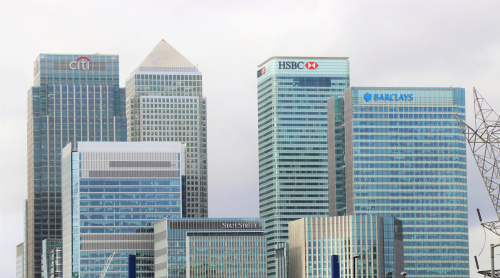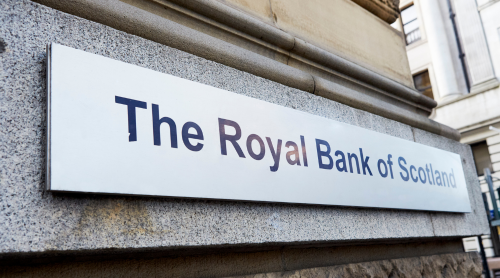The United Kingdom’s financial landscape boasts a robust array of banking institutions that play a pivotal role in shaping the nation’s economic dynamics. Among these, the top 10 banks in United Kingdom stand out as significant powerhouses, influencing everything from individual financial stability to corporate growth. These banking giants not only serve as pillars of financial security for their customers but also contribute extensively to the country’s economic growth and stability.
Top 10 banks in United Kingdom – 2023
- HSBC Holdings
- Lloyds Banking Group
- Royal Bank of Scotland Group
- Barclays
- Standard Chartered
- Santander UK
- Close Brothers Group plc
- Nationwide Building Society
- Schroders
- Yorkshire Bank
1. HSBC Holdings

HSBC Holdings plc, known as the Hong Kong and Shanghai Banking Corporation, is a British universal bank with historical ties to East Asia and a strong multinational presence. Headquartered in London, it’s Europe’s largest bank by total assets, with a remarkable $2.953 trillion as of December 2021. HSBC manages vast amounts of assets under custody and administration.
The bank’s origins trace back to British Hong Kong, where it started as a hong trading house. It expanded to Shanghai in 1865 and was formally incorporated in 1866. In 1991, HSBC Holdings plc was established in London, making the Hong Kong-based bank its subsidiary. The following year, HSBC acquired Midland Bank, becoming a significant domestic player in the UK.
HSBC operates across 64 countries, serving about 40 million customers globally. In 2023, it ranked 20th among large companies by Forbes’ standards. The bank holds primary listings on the Hong Kong and London Stock Exchanges, is part of key indices, and has secondary listings on the New York Stock Exchange and Bermuda Stock Exchange.
2. Lloyds Banking Group

Lloyds Banking Group emerged as a British financial institution resulting from Lloyds TSB’s acquisition of HBOS in 2009. It holds its place among the notable financial services organizations in the UK, serving a substantial customer base of 30 million and maintaining a workforce of 65,000 employees. The origin of Lloyds Bank can be traced back to 1765, while the broader legacy of the Group reaches over 320 years, harking back to the establishment of the Bank of Scotland by the Parliament of Scotland in 1695.
The Group’s primary headquarters is situated at 25 Gresham Street in London’s City, and its registered office is positioned on The Mound in Edinburgh. It also operates from various office locations, including Birmingham, Bristol, West Yorkshire, and Glasgow. Beyond the UK, the Group extends its operations significantly across the US, Europe, the Middle East, and Asia. For its EU operations, the headquarters are located in Berlin, Germany.
Within its diverse portfolio, the Group operates under distinct brands such as Lloyds Bank, Halifax, Bank of Scotland, and Scottish Widows. António Horta-Osório, the former Chief Executive, highlighted the importance of preserving these distinct brands, driven by the unique attitudes of their respective customer bases.
Lloyds Banking Group is listed on the London Stock Exchange (LSE) and is a constituent of the FTSE 100 Index. As of August 1, 2022, its market capitalization was approximately £30.65 billion, positioning it among the top 20 LSE listed companies. Furthermore, the Group maintains a secondary listing on the New York Stock Exchange through American depositary receipts.
3. Royal Bank of Scotland Group

The Royal Bank of Scotland plc, known as Banca Rìoghail na h-Alba in Scottish Gaelic, holds a prominent position as a retail and commercial bank in Scotland. As one of the retail banking subsidiaries of the NatWest Group, it stands alongside NatWest (serving England and Wales) and Ulster Bank. With approximately 700 branches, the Royal Bank of Scotland’s presence is primarily concentrated in Scotland, although it also maintains branches in various larger towns and cities throughout England and Wales. It’s important to note that the Royal Bank of Scotland and the Bank of Scotland, both based in Edinburgh, are distinct entities. Notably, the Bank of Scotland predates the Royal Bank by 32 years. The establishment of the Royal Bank of Scotland was driven by the aim to create a bank with strong Hanoverian and Whig connections.
In 2019, subsequent to the ring-fencing of the Group’s core domestic operations, the bank assumed the status of a direct subsidiary under NatWest Holdings. The Group’s investment banking arm is known as NatWest Markets. In 2018, the former RBS entity was officially renamed NatWest Markets to establish its legal identity. During the same period, Adam and Company, which held a separate PRA banking license, underwent a name change to become The Royal Bank of Scotland. Adam and Company continued to function as an RBS private banking brand until 2022.
4. Barclays
Barclays is one of the biggest banks in the United Kingdom, which is a great achievement for any company. They have many services available to their clients such as credit cards, savings accounts, loans, mortgages, and more. One of the best things about Barclays is that they have a lot of branches around the country, which means that you can easily go to a branch if you need to make a payment or make an application for a loan.
Barclays bank is one of the most popular banks in the United Kingdom. The bank offers a wide range of products and services to its customers. It is the fourth largest private sector employer in the United Kingdom and has a market capitalization of £35.5 billion.
Barclays is a global bank with headquarters in the UK and over 90,000 employees worldwide. It is the third largest bank in the United Kingdom by market value and is one of the largest banks in the world. The bank provides banking services, such as personal, corporate and investment banking. It has also been involved in retail banking, credit cards and mortgages. The bank has more than 1,200 branches in the UK and more than 80,000 ATMs.
5. Standard Chartered Bank

Standard Chartered plc stands as a prominent British multinational bank, engaging in diverse operations encompassing consumer, corporate, and institutional banking, along with treasury services. Despite being headquartered in the United Kingdom, the bank does not engage in retail banking activities within the UK. An interesting facet of its financial landscape is that approximately 90% of its profits are derived from its operations across Asia, Africa, and the Middle East.
Within the financial markets, Standard Chartered holds a primary listing on the London Stock Exchange and serves as a constituent of the FTSE 100 Index. In addition to this primary listing, the bank holds secondary listings on the Hong Kong Stock Exchange, the National Stock Exchange of India, and the OTC Markets Group Pink. Notably, the Government of Singapore-owned Temasek Holdings claims the position of its largest shareholder. Given its significance within the financial sector, the Financial Stability Board recognizes Standard Chartered as a systemically important bank.
Overseeing the bank’s operations is José Viñals, who serves as the Group Chairman of Standard Chartered. Taking on the leadership of the organization as the Group Chief Executive is Bill Winters.
6. Santander UK

Santander UK plc, operates as a British bank under the ownership of the Spanish Santander Group. Operating independently, Santander UK plc is managed by its local team and is solely responsible for its performance.
With a notable presence, Santander UK is a key provider of personal financial services within the United Kingdom. It holds a significant position as one of the leading contributors to the mortgage and savings landscape in the country. With a workforce of approximately 20,000 individuals, the bank serves a substantial customer base of 14 million active clients and operates through 64 corporate business centers.
Situated at Regent’s Place, London,, United Kingdom, the bank’s origins trace back to January 11, 2010. This marked the merger of Abbey National plc with the savings business and branches of Bradford & Bingley plc, leading to the renaming of the entity as Santander UK plc. Following this, Alliance & Leicester plc was also integrated into the newly rebranded business in May 2010.
A survey conducted by moneysavingexpert in March 2020 showcased Santander’s strong customer satisfaction, placing it as the second-highest among major high street banks. However, it’s noteworthy that Moody’s downgrade of the credit rating of several UK financial firms, including Santander UK, in October 2011 highlighted financial vulnerabilities. By June 2012, Moody’s positioned Santander UK in a more favorable financial standing compared to its parent company, Banco Santander. Additionally, it’s worth mentioning that less than 1% of Santander UK’s business is conducted abroad.
7. Close Brothers Group plc
Close Brothers, founded in 1878 by the Close brothers, started as a farm mortgage provider in Sioux City, Iowa. Over the years, it underwent significant developments, including Alaska’s first railway construction by William Brooks Close in 1897.
The company went through a management buy-out in 1978 and was listed on the London Stock Exchange in 1984. Expansion occurred through strategic acquisitions in the 1980s and 1990s, including Winterflood Securities, Hill Samuel’s Corporate Finance Division, and Rea Brothers.
Close Brothers acquired UK short-term lender Commercial Acceptances Group in 2008 but refocused in 2009 after Daiwa Securities SMBC’s acquisition of its corporate finance business. Notable divestitures included the sale of its German securities business to Oddo et Cie in 2014.
Close Brothers’ Banking division serves small and medium-sized businesses and individuals, offering loans and deposit-taking. Winterflood, a key player in the UK market, trades in various venues and covers LSE listed stocks, AIM, and ICAP Securities and Derivatives Exchange.
Adrian Sainsbury has been the CEO since 2020, but his pay increase drew criticism in 2021. Mike Biggs has chaired the board since 2017.
8. Nationwide Building Society

Nationwide Building Society is a British mutual financial institution and holds the distinction of being the world’s largest building society, as well as the seventh-largest cooperative financial entity. With a substantial membership exceeding 16 million individuals, it plays a pivotal role in the financial landscape. The institution’s headquarters are situated in Swindon, England.
Nationwide’s organizational structure encompasses a diverse array of approximately 250 building societies. Noteworthy milestones include mergers with the Anglia Building Society in 1987 and the Portman Building Society in 2007, which have contributed to its strategic growth. These developments have propelled Nationwide to its current status as the second-largest provider of household savings and mortgages within the UK, accompanied by a noteworthy market share of 10.3% in current accounts for the 2021/2022 financial year.
In the financial year 2021/2022, Nationwide demonstrated its financial strength with assets valued at around £272.4 billion. This achievement is particularly remarkable given that it exceeds the cumulative assets of the remaining 42 British building societies combined, which collectively amount to £483 billion for the entire building society sector.
Nationwide actively participates in several significant industry associations, including the Building Societies Association, the Council of Mortgage Lenders, and Co-operatives UK.
9. Schroders Plc
Schroders plc operates as a distinguished multinational asset management firm, with its headquarters situated in London, England. Its establishment dates back to 1804, and it boasts a global workforce exceeding 6,000 individuals, spread across 38 locations encompassing Europe, America, Asia, Africa, and the Middle East. This extensive presence underscores its prominence as a global player.
The company’s shares are listed on the London Stock Exchange, and it holds the distinction of being a constituent of the FTSE 100 Index, further solidifying its position in the financial markets.
Schroders takes its name from the Schröder family, an esteemed Hanseatic family hailing from Hamburg and extending its influence to other regions. The Schröder family retains a significant stake in the company through various means, including trustee companies, individual ownership, and charitable entities. This collective ownership enables them to exert control over approximately 47.93% of the company’s ordinary shares.
10. Yorkshire Bank
Clydesdale Bank plc employs the trading name Yorkshire Bank for its retail banking activities in England.
Originating in 1859 as the West Riding of Yorkshire Provident Society and Penny Savings Society, Yorkshire Bank’s early history saw the abandonment of the Provident Society aspect, leading it to be known as the West Riding of Yorkshire Penny Savings Bank. Following subsequent name abbreviations, the bank formally adopted its present name in 1959.
What set the bank apart was its distinctive model of direct ownership over a wide network of penny banks, channeling funds into a Central Office. By the late 1800s, it had outgrown even the Trustee Savings Banks in size. However, a potential risk of savings withdrawal emerged in 1911, prompting the bank’s acquisition by a consortium of clearing banks.
In 1990, National Australia Bank (NAB) took over the bank, and in 2005, it was merged into another NAB subsidiary, Clydesdale Bank. Despite the merger, Yorkshire Bank retained its distinct trading division. Subsequently, in 2016, NAB divested its UK operations, forming CYBG plc, which then acquired Virgin Money plc in 2018. The gradual transition to the Virgin Money brand has led to the phasing out of the Yorkshire Bank name.
Final words
The top 10 banks in United Kingdom emerge as vital players, steering the nation’s economic course. Their services span a diverse market segments, catering to the needs of individuals, businesses, and beyond. As these banking giants continue to evolve, adapting to technological advancements and changing financial landscapes, their role remains integral, fostering economic growth, stability, and prosperity within the United Kingdom and beyond.

